CRISIS FOR GRASSROOTS FOOTBALL PITCHES
And the selling of Wembley Stadium
by TurfPro Editor, Laurence Gale MSC, MBPR
With the FA saying only one in three pitches at grassroots level is of adequate quality, something must be done to raise standards.
As an ex sportsman and coach I have been reading with interest the recent press coverage in the national news regarding the selling off of Wembley Stadium to help fund grassroots football.
Plans to sell Wembley Stadium for £600m have been called "ridiculous" by former England player Gary Neville. The Football Association says the sale could transform community facilities.
But Neville told MPs there were other ways revenue could be generated, such as a levy on agents' fees or reducing Premier League prize money. See BBC article here.
"The FA feels to fund the grassroots programme, they have to sell a national asset - it's quite simply ridiculous," the BBC quoted the ex-Manchester United defender.
Only one in three pitches at grassroots level is of adequate quality, says the Football Association.
The figure is part of the FA's written evidence for a Digital, Culture, Media and Sport (DCMS) parliamentary hearing on Wednesday about the possible sale of Wembley Stadium.
In this article on the BBC the FA says it is "considering a sale because it represents a transformative opportunity" to change "the poor state of community football facilities".
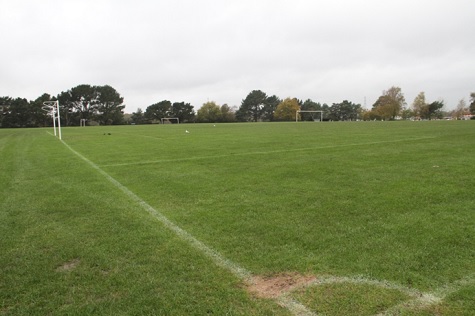
Well, after reading both pieces I am more inclined to agree with Gary Neville! Why? Because he speaks common sense, has played and managed the game at the highest level and knows only too well the colossal amounts of money that could be generated via other means.
For me they should sell Wembley, remove the burden of running this stadium and invest the money into developing a better strategy of managing the fundamentals of the game, starting at grass roots levels. The national team may still be able to play at Wembley or utilise many of our premier status stadiums up and down the county.
As listed in their report, the FA stated they are very aware of the problems with grassroots football.
There are 21,000 grassroots clubs, 50 county FAs, 25,000 schools and 330 local authorities which are catered for by the FA and, along with the finding that only one in three grassroots pitches are of adequate quality, the FA's written evidence also highlights:
- 150,000 matches were called off last season due to poor facilities
- One in six matches are called off due to poor pitch quality
- 33 of 50 county FAs are without their own 3G pitch
- Cancelled matches account for the equivalent of 5,000,000 playing opportunities lost this year because of poor facilities
- There are half the number of 3G pitches in England than there are in Germany
"The word for grassroots football is 'crisis,'" said Kenny Saunders, who runs pressure group Save Grassroots Football. "Government cuts to local councils are having a massive impact.
"Councils can't maintain pitches and more of them are selling them off."
From my own experiences, I have witnessed myself the deterioration of many parks, schools and grassroots club pitches, purely down to the lack of investment.
For many clubs, the reality is that these pitches only get cut and marked out with some token renovation work done to reseed some bare areas at the end of the playing season. This is clearly not enough investment, and one of the reasons we are seeing deterioration in grassroots pitches.
We need to change that mentality and advise and educate these clubs and schools of the benefits of maintaining these pitches properly.
The actual overall cost of maintaining a grass pitch is relatively cheap in the scale of things. You either invest in equipment and products, doing the work yourselves or you pay a local contractor to undertake the work. Based on one single pitch, a contractor should be able undertake work such as mowing, fertilising, weedkilling, marking and aerating the pitch throughout the season along with a typical end of season renovation - and it may cost you between £8-10,000.
I believe it is the role of the FA to educate clubs and clearly give them incentives to undertake this essential work and provide a safe consistent playing surface for the next generation of footballers.
As Gary Neville points out there are millions of additional pounds that could be raised by the FA via taxing the Premiership football clubs, TV companies and current major sponsors to ensure grassroots pitches can be maintained and managed to increase participation in the years to come.
 |
|
 |  |
SIMON TULLETT
Well known industry figure dies
Simon Tullett, founder of STM Co Ltd of Warwickshire, a supplier of SCAG equipment, died in hospital recently.
Simon Tullett, founder of STM Co Ltd of Warwickshire, a supplier of SCAG equipment, died in hospital recently.
He had been suffering from health problems for a number of years and was awaiting heart surgery, but sadly succumbed to kidney failure.
Simon Tullett founded STM Co Ltd in 1990, drawing on the knowledge and experience he had acquired from a lengthy career within the agricultural and horticultural machinery market.
Since that time STM has earned a reputation for distributing high quality products with aftersales, spares, training and servicing in support.
Dominic Mason took over as owner of the company in January 2015.
A statement on behalf of the company, expressing great sadness at his passing, said, "His was the vision that saw the arrival of SCAG machinery in this country, and their popularity is testament to the product and the company that he created, now with over thirty years of trading to its name.
"He was a larger than life character and will be missed.
"He leaves wife, Jayne, who helped tirelessly at Saltex for many years, and his daughter Olivia."
 |  |
COUNCIL WORKER MOWS DOWN BIG BUTTERFLY COUNT MEADOW
Area was being monitored for Sir David Attenborough scheme
It was widely reported last week that an East Devon District Council employee 'misunderstood' his job and completely mowed flat a meadow being watched for a national survey.
It was widely reported last week that an East Devon District Council employee 'misunderstood' his job and completely mowed flat a meadow being watched as part of the Sir David Attenborough-backed, Big Butterfly Count.
The meadow at The Knowle, in Sidmouth was just supposed to have a pathway cut through the field - but instead the worker completely mowed flat the entire nine acre site.
Devon Live reported that the wildflower meadow was blooming with all kinds of flora including orchids and bristling with butterflies, birds and insects.

Devon Live pictured the meadow before . . .
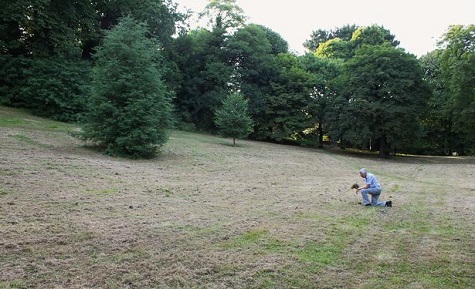
. . . and after
Conservationist Ed Dolphin had been counting butterflies the previous day for the national survey and turned up the next day to find butterflies and wildflowers were all gone.
Mr Dolphin told Devon Live, "I was horrified because it wasn't just the number but the sheer variety of butterflies there - at least eight different sorts - the day after there was just one, a good old cabbage white.
"It's tidy but it's more like a desert.
"Mowing it when they did and leaving the cuttings on is going to mean fewer wildflowers next time."
The BBC quoted a spokesperson for East Devon District Council as saying,"We regret that one of our operatives misunderstood the instructions he was given and cut the arena area by mistake, instead of just cutting some pathways and a flat area to help those using the park for walking through.
"We agree this shouldn't have happened and will be taking measures to ensure that this doesn't happen again next year."
 |  |
IOG SAY AWARDS TICKETS SELLING FAST
And announce after-dinner comedian
Celebrating the achievements of volunteer and professional grounds teams, as well as community clubs and national stadia, the awards take place on the first night of SALTEX.
The Institute of Groundsmanship (IOG) say that tickets are selling fast for their Industry Awards - with the 10th anniversary event being held on October 31 at the Hilton Metropole hotel at the Birmingham NEC, on the evening of the first day of SALTEX.
Celebrating the achievements of volunteer and professional grounds teams, as well as community clubs and national stadia, the awards will be hosted by Mark Saggers from talkSPORT radio, and comedian, writer and actor Tom Allen will be providing the after-dinner entertainment.
Tom will be presenting his unique style of sharp, acerbic wit and camp, as well as riotous storytelling to the audience of groundscare devotees and sports administrators and personalities.
He started as a stand-up comedian at the age of 22 and went on to win So You Think You’re Funny in Edinburgh and the BBC New Comedy Awards. He has since performed to audiences around the world and has appeared on 8 Out of 10 Cats Does Countdown, Mock the Week, The Great British Bake Off’s Extra Slice, Celebrity The Crystal Maze as well as the John Bishop Show, Channel 4’s Comedy Gala and Just a Minute.
To secure your seat at the event - which cost £95 each for IOG members and £190 each for non-members - contact the IOG by email (awards@iog.org) or call 01908 312 511 where you can also gain details of how to become an IOG member.
 |  |
REESINK TURFCARE AWARD THEIR DEALERS
Commendations for Aftermarket service
Reesink Turfcare have presented awards for Outstanding Performances in the three areas of Service, Parts and Skills, as well as recognising an overall Dealer of the Year.
Reesink Turfcare has announced the winners of its Aftermarket Dealer Awards.
The awards commend Outstanding Performances in the three areas of Service, Parts and Skills, as well as recognising an overall Dealer of the Year for ‘Excellence in Customer Support’.
In keeping with its Service Level Agreement (SLA), which benchmarks great customer service, Reesink awards those dealers achieving the best scores, rated on quarterly Key Performance Indicators (KPI), within each of the three sections, while the Dealer of the Year Award combines the KPI scores from all three.
The winners are:
Outstanding Performance in Service goes to Redtech in Coventry, while Lloyd Ltd in Carlisle excelled in Skills, and Revill Mowers in Gloucestershire in Parts.
The coveted Dealer of the Year award has two joint winners: Cheshire Turf Machinery in Stockport and Revill Mowers in Gloucestershire.
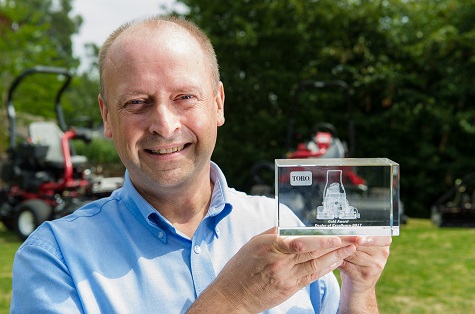
Joint winner Mark Woodward, service director at Cheshire Turf Machinery
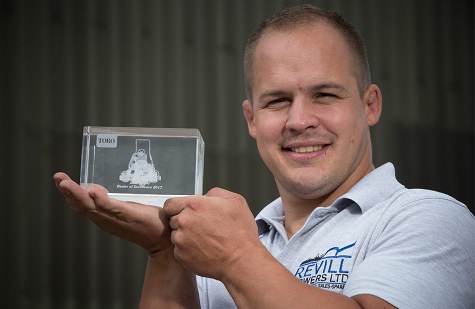
Joint winner Jason Revill, joint director at Revill Mowers
The runners-up are: Russells Groundcare in Yorkshire for both Parts and Service, and Oliver Landpower in Kings Langley for Skills.
David Jackman, Reesink’s aftermarket manager says that ever since Reesink adopted the principles of a customer service level agreement to set a baseline standard for after-sales customer support in 2015, its strategy has been to ensure that it delivers strong customer service with all its business partners. David said, “We’re looking to continually improve on our customer experience after a sale completes, and our Service Level Agreement outlines the core customer service standards, goals and considerations adopted by all our Authorised Service and Dealer Locations, which helps to earn the loyalty of our customers.
“Part of this extensive remit are the awards, which give us a standard set of common goals, targets and values that can be shared and promoted to the end user, benefiting customer retention and business growth across our dealer network. As we expected it would be, this has been met with great enthusiasm by our dedicated dealers and has done a fantastic job of driving the aftermarket business forward.
“We’re delighted to be able to recognise the winners and runners-up of these awards, which not only provide a snapshot of each dealers’ performance with us but also our support for them. Overall, the major benefit of this process is the benefit it brings to the end customer, which is what we’re all in it for.”
 |  |
MADEJSKI PITCH RECONSTRUCTION
Higlights value of turf and irrigation technology
When the Madejski Stadium underwent its first major pitch reconstruction for ten years contractors, MJ Abbott and Premier Pitches, worked closely together during the time-critical period.
When the Madejski Stadium, home to Reading Football Club and London Irish Rugby Club, underwent its first major pitch reconstruction for ten years contractors, MJ Abbott and Premier Pitches, worked closely together during the time-critical close season over a six-week period.
The venue became the first to have a dual-use pitch with the SISGrass hybrid system turf technology.

During the later stages of construction, employing effective irrigation to the grass root zone was critical to enable the final pitch levels to be accurately graded and to allow for successful cultivation and seeding of the new surface. Nathan George, Contracts Manager at MJ Abbott says he was confident that selecting Rain Bird products for the new pitch's irrigation requirements was the way forward.
After removing around 15 miles of existing pipework, MJ Abbott completely reconstructed the pitch, taking the old one out and starting from the bottom up, reshaped all the sub-base levels, reinstalled the drainage, undersoil heating and rootzone layers. Premier Pitches took responsibility for pitch cultivation and seeding. The company also maintains their involvement by way of annual pitch renovation.
Nathan George comments, “The irrigation cycle is determined by both the weather in general as well as the effects of sun and shade caused by the inherent design of the stadium. We had a high level of confidence in Rain Bird irrigation technology for the project because of the overall quality, performance and versatility of the company's products.”
Rain Bird's 8005 rotors were specified for the central area of the pitch and with their adjustable arc from 50° to 330°and 12 to 24.7 metre radius were well suited to the application. Featuring Rain Curtain nozzles, the company says the 8005 rotors ensure optimum distribution and close-in watering resulting in superior irrigation uniformity.
Rain Bird's 950E rotors were selected for the pitch perimeter as they are specifically designed to withstand the rigours of sports field irrigation applications, including hybrid grass. They offer full or part circle and irrigation up to 345° and feature a top adjustable pressure regulator, factory preset at 5.5 bar.
Rain Bird's Site Control System, used by Adam Grantham Reading Football Club's Grounds Manager and his team, can be controlled both through a PC and remotely through an iPad. It gives complete control over the irrigation and the flexibility to set up and match the irrigation cycles precisely to the prevailing and predicted weather. The software provides a quick and easy way to build irrigation schedules and programmes based on set parameters. The system's features include an interactive map interface that displays the position and operation of individual rotors, displaying real-time irrigation activity and for close monitoring of the system.
Smart Weather tracks evapotranspiration (ET) values and rainfall via the weather station and reacts to current weather conditions based on defined sensor thresholds. The operator is immediately alerted if thresholds are exceeded and irrigation can be implemented for optimum turf conditions. Flo-Graph provides real-time graphics of individual station information and Flo-Manager balances system demands and maximum capacities with efficiency, helping to lower water demand, reduce system wear and tear and save energy.
Adam Grantham commented, “The Rain Bird system is great and very user friendly, and can be as complex as you would like it to be. I have found it very easy to monitor moisture levels with the sprinkler system coverage being very consistent. The pitch is holding together well and receiving good feedback from the coaching staff and players”.
 |  |
ALLETT LAUNCH NEW CYLINDER MOWER
Addition to professional range
Designed to meet requests from groundsmen in Europe and the USA, Allett say the C27 offers ‘Quick Cartridge’ options.
Allett Mowers have introduced a new 27” cylinder mower to their professional mower range.
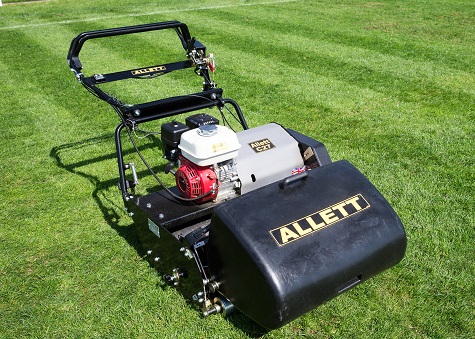
Designed to meet requests from groundsmen in Europe and the USA, Allett say the C27 offers the ‘Quick Cartridge’ options that effectively make these mowers eight machines in one. Powered by the Honda GX200 engine, the company says the 27” cylinder cutting system, with substantial front and rear rollers, ensures the user gets a superior cut, levelness of finish and longer lasting, more crisply defined stripes.
The six bladed cylinder produces 111 cuts per metre (101 cuts/yard) while the eight blade will give 148 cuts per metre (135cuts/yard) irrespective of forward speed. Effortless mowing is equally assured, say Allett, with handle-mounted levers for drive and cartridge engagement and the adjustable handlebars have anti-vibration mountings.
Together with the 6 and 8 bladed cylinders the optional accessories include a scarifier cartridge with Tungsten tipped blades, a Sorrel Roller, Turf Rake, Verticut and Brush. There is also the option of a trailing seat to turn the C27 into a ride-behind for faster cutting over large areas and it benefits from a 3.1 litre fuel tank. A cut height of 8mm to 55mm (0.32”- 2.17”) is featured.
With the front and rear rollers of a cylinder mower close to the point at which the grass is cut, the user can achieve very low heights of cut without scalping. The rear roller on the C27 is a rubber covered 3-piece steel roller with steel spur end differential. The front roller is grooved aluminium with scraper and sealed end bearings, though there is an option of a plain roller.
The working width of the mower is 686mm/27”, the overall width 900mm/38” and it weighs 135kg (297lb). The grassbox is moulded plastic with a steel reinforcing strip.
 |  |
NEW AMENITY-SPECIFIC WEBSITE LAUNCHED
Germinal aim site at landscape architects and turf professionals
Aim of new website is to simplify the process of selecting the most appropriate grass seeds, wildflower mixtures and fertiliser options.
Germinal has launched a new amenity website, the aim of which they say is to simplify the process for landscape architects and turf professionals to select the most appropriate grass seeds, wildflower mixtures and fertiliser options.

The new website, www.germinalamenity.com, includes complete specifications and usage guides for Germinal’s Grade ‘A’ range of landscaping and sports grass seed mixtures as well as full details of its grass and wildflower landscaping mixtures for everything from low maintenance reclaimed land to saline road verges, shaded habitats, fine lawns and an array of natural habitats. All product details can be cut and pasted into external documents, making it simple for landscape architects to insert them directly into the appropriate project specification.
“As well as constantly investing in research and development to bring first class grass and wildflower seeds and turf care products to the landscaping and sports turf sectors, we are also conscious of the constant need to provide the industry with the latest news and advice,” explains Richard Brown, Germinal Amenity Sales Manager.
“Our range of ‘Grade A’ grass seed mixtures is always evolving. The new website has therefore been developed to make it easier for new and existing customers to keep abreast of our developing range of products and to enable them to specify the most appropriate products to suit each site’s individual requirements.
“We’ve also populated the new website with a collection of advice guides and video resources covering a range of useful topics from simple over-seeding and sowing ‘how-to’ guides, to more detailed explanations of the importance of key success factors such as soil pH, the use and application of macro and micro nutrients and how to physically manage recently renovated and established swards and amenity landscapes.”
The website also contains a selection of standardised fertiliser plans - written and designed by Germinal’s FACTS (Fertiliser Advisers Certification and Training Scheme) qualified experts - to enable everyone from novice gardeners to professional turf growers to get the best results from their amenity facilities.
The new website also features a ‘Product Selector’ tool which has been designed to make it as easy and simple as possible for landscape architects to find the most appropriate products for each project’s specific needs.
Another new section, which contains details of a range of CPD resources and seminars, has also been added.
 |  |
OTTERBINE DIFFUSES THE SITUATION
Frilford Heath praise system
Course manager Sid Arrowsmith said investment was intended to make the water good enough quality to irrigate the course.
Weeks of high temperatures have turned golf courses across the country brown and triggered Amber health warnings, and while Otterbine distributor Reesink say there’s not much to be done to counteract either, one thing they say you can do is keep your lakes and ponds well aerated to prevent them from becoming stagnate.
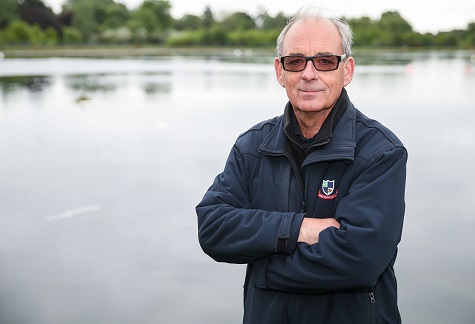
Course manager Sid Arrowsmith with Frilford Heath’s 6m, 10-million-gallon reservoir which is irrigating the 54-hole championship golf course complex
An example of this on an large scale comes from Frilford Heath, the 54-hole championship golf course complex near Oxford, which had an Otterbine Air Flo 3 diffuser installed in its 6m, 10-million-gallon reservoir to aerate the water two years ago. The idea was to make the water good enough quality to irrigate the course, says course manager Sid Arrowsmith.
“We always knew this was a long-term and challenging project. The water comes from a brook downstream through farming fields, full of pollutants and run-off nitrates,” Sid says. “Add to the fact that the silt and sediment at the bottom of the reservoir literally hadn’t seen the light of day for ten years and we knew the diffuser had its work cut out. Even so, none of us expected the extent!
“We experienced, as anticipated, algal growth; the surprise was how much algal growth! Reesink’s Rob Jackson visited us regularly and I think even he was surprised at how abundant it was.”
Water full of nutrients like Frilford Heath’s is, as Sid explains, “going to have an inordinate amount of organic mixture in it”. However, the Air Flo 3 kept busy and Sid “never once doubted” it was up to the job.
The water now is crystal clear again and while Sid is under no illusion that an algal bloom is possible, especially in this weather, the diffuser is ready for the challenge. “There is more oxygen in that reservoir than ever before. If we did incur another algal bloom, the water is in the best possible position to counteract it.”
Meantime, the water is being used all over the course, doing exactly what Sid intended. So, at what saving does this come? “Back in the very dry summers of ‘94, ‘95 and ‘96, we were spending £25,000 a year irrigating the course off the mains. It is literally a fraction of that now. The only thing we use mains water for is washing the turf machinery and toilet facilities.”
For Sid, the Otterbine diffuser has done exactly what he intended it to do - it has made 10-million-gallons of water ready to use and given the club a degree of self-sufficiency it hasn’t experienced before. And as Sid, a greenkeeping veteran, one of only 70 BIGGA Master Greenkeepers in the UK and ex-BIGGA president, says: “greenkeeping wouldn’t be greenkeeping without a few challenges along the way!”
 |
|
 |  |
ADVERTISE YOUR JOBS HERE
Amazing success rates!
Advertise your recruitment needs on TurfPro Weekly Briefing and reach our targeted audience of recipients every week.
Contact Susan Pallett for details - 01491 837117
|
SHOWCASE YOUR NEW PRODUCTS HERE
Have your new equipment seen first!
Use this Weekly Briefing to showcase your new products to our ever-growing community of specialist dealers.
Contact Susan Pallett - 01491 837117
|
 |  |
 |  |
 |  |
 |  |
LORD'S 'GRASS-GUVNOR' TO RETIRE
Mick Hunt bows out after 49 years
by Chris Biddle, Turf Pro Consultant Ediitor
With the news that MCC Head Groundsman, Mick Hunt is to retire at the end of this year, TurfPro Consultant Editor, Chris Biddle, has penned this appreciation.
“Lords is history modelled in turf and building” -
J M Kilburn
Look towards the sidescreen at the Nursery End during a Test Match, and you’ll often spot Mick Hunt in the groundsman’s ‘paddock’ beneath the Media Centre. Furrowed brow, arms folded, eyes searching the weather coming from the back of the Pavilion. Watching for signs when the grounds staff might have to rush onto the field for rain or bad light.
Mick spends a lot of time looking at the sky.
He’ll have all the latest weather gizmos at his disposal, but rather like a farmer, there is no substitute for having that in-built radar, for Mick Hunt’s ‘crop’ is the expanse of fine turf at the most celebrated cricket ground in the world.

Despite the changing face of architecture over the years, mixing old with the new, the focal point of Lord's Cricket Ground remains the playing surface. The pavilion, the stands, the hospitality boxes there to support the main purpose of the venue.
Like all professional groundsman, Mick Hunt is fiercely protective of his domain, no more so than the pitches prepared for Test Matches (normally two a year). “We treat them with kid gloves - and even get angry when someone looks at them!”
This week, Mick will prepare the stage for his last Test Match (England v India starting Thursday). His has been a remarkable, consistent and resilient career, rarely receiving the plaudits, in the firing line when things don’t go to plan - as is the groundsman's lot.
A keen club cricketer in his youth, he lived ‘a good six hit’ from Lord's and after seeing a vacancy joined the ground staff in 1969 working under head groundsman Jim Fairbrother who had taken over the role the previous year. After Fairbrother’s death in 1984, Mick was promoted to replace him thus becoming the 9th head groundsman at Lord's.
His first Test Match in charge was the Ashes Test Match of 1985, won by Australia by 4 wickets with Allan Border scoring 196 - so no gripes from the Aussies about the pitch prepared by the new man in charge.
Cricket is such a stats-driven game that it is worth reflecting on Mick Hunt’s contribution to major international games at Lord's. In the 49 years he has been at cricket headquarters, he will have been involved in preparing the playing surface for:
- 24 Test Matches working on groundstaff with Jim Fairbrother
- 63 Test Matches as Head Groundsman (including an Australia v Pakistan Test played at Lords in 2010 , and the 1970 England v Rest of World ‘Test’ which was not recognised officially)
- 12 One Day International working on groundstaff with Jim Fairbrother (inc 3 World Cup Finals)
- 50 One Day Internationals as Head Groundsman (inc one World Cup Final)
That’s a total of 149 Test Matches and ODIs - 113 of them as Head Groundsman.
With Lords hosting around 30 other matches this year, from the Royal London Cup Final to Twenty20 games and the National Village Cup Final, you can work out that Mick will have prepared over 4,000 pitches and outfields during his time at Lords.
OUTFIELDS AND OLYMPICS
For all its fabled ‘hallowed turf’ status the Lord's playing surface has is inperfections and has been a challenge to Mick over his whole career.
Notably the slope. The outfield falls 8ft 6” from the square which itself is not totally level. “If I could change one thing about Lord's, I’d like a nice, level square,” says Mick. “But to backfill and level the surface down to the Mound Stand you would need to dig up half of Lancashire” (and presumably lose several rows of seats).
But in 2003, that is exactly what they did to Lord's itself which had always been prone to flooding. “There has only to be a cloud in the sky for the ground to puddle,” he said. It was particularly bad in the early 80s when eight hours had been lost during the Test against India, over nine hours in the West Indies Test, and then embarrassingly ten hours during the showpiece Centenary Test in 1980 - which even resulted in a reported punch-up in the pavilion.
Lord's was built over dense London clay, surface water simply stayed where it lay and days of cricket were lost along with valuable revenues. The decision was taken to rip out the outfield, leaving Mick’s treasured square as a pristine island in the midst of acres of bare soil. Over the period September 2002 to April 2003, 16,000 tonnes of turf and top soil were removed involving 800 lorries. New drains, state-of-the-art irrigation systems and rootzone were put in before final turfing. For months the playing area looked like a building site, but come the Spring, spectators attending the first game of the season will have been visually unaware of the dramatic reconstruction of the ‘earth beneath’.

The £1.25 million expense was totally vindicated in 2007 on the second day of the Test Match against India. A thunderstorm hit the ground shortly after breakfast when over an inch of rain fell on the ground which soon resembled a lake. Before the outfield renovation, play would have been lost for the day, and possibly for a couple of days. Yet, spectators were amazed to see the water simply fall through the surface - and play commenced before lunchtime.
A re-turfing of the outfield was also required when Lord's was chosen as a venue for the 2012 Olympic archery competition. A full programme of cricket was played until 1 July after which control of the venue passed from the MCC to the International Olympic Committee. You can imagine that Mick Hunt was not too chuffed, within weeks his outfield was filled with stands holding 5,000 people. The square however was out-of-bounds so that regular mowing and maintenance could continue.

The archery final took place on 3 August and the race was then on for Mick and his team to return Lord's to its pristine state in readiness for a Test Match against South Africa on 16 August. A third of the outfield was relayed and on the opening day the ground presented itself to players and spectators with little sign of the enormous upheaval. It had been an ‘Olympian’ feat by Mick, his grounds crew and the turf contractors. “Afterwards, the pitch was marked as very good by the match referee,” said Mick with a mixture of pride and relief.
KEEPER’S VIEW
It is clear that Mick is highly regarded by players, umpires and officials. He has a good relationship with them, they trust him and value his knowledge and integrity. We were chatting on the boundary edge some years ago during a county match when Justin Langer (then Middlesex captain) walked by. “Great track, Mick, great track,” he said. But then he just had scored a big hundred. “Not sure the opposition bowlers would agree,” said Mick, “but then my yardstick for how a pitch is performing is always the keeper. They know how it is coming through, how it’s hitting gloves. My overriding aim has always been to produce a pitch that provides a good contest.”
Like every Test Match venue, the ‘strip’ is analysed, prodded and poked, filmed in macro-detail and analysed to the ‘nth-degree. Steve Birks, head groundsman at Trent Bridge once described the pressures; “Sometimes it’s so much hassle, it’s as if we were dealing with a nuclear weapon not a cricket pitch! Looking after the ground is easy, the hardest job is dealing with people.”
The scrutiny today is much more intense than it was when Mick took over as head groundsman with administrators, television companies, the media all pitching in to give their views on 22 yards of living, breathing, wearing material.
Mick Hunt has always presented a self-effacing, quiet, critical approach to his role. Fame and adulation does not sit easily with him. Describe him as a legend of his profession and he’ll shrug off the compliment. It is clear that the MCC have enormous respect for the person who has looked after their most valuable asset for almost half a century. They also know that he is very much his own man, does things his way with the interest of Lord's and the game of cricket always at heart.
As the longest serving MCC staff member, Mick was recognised by the MCC in 2014 when he was invited to ring the 5 minute bell before the start of the MCC Bicentenary match against the Rest of the World XI. He was delighted at the honour, but still looked a little embarrassed at the inevitable media coverage.
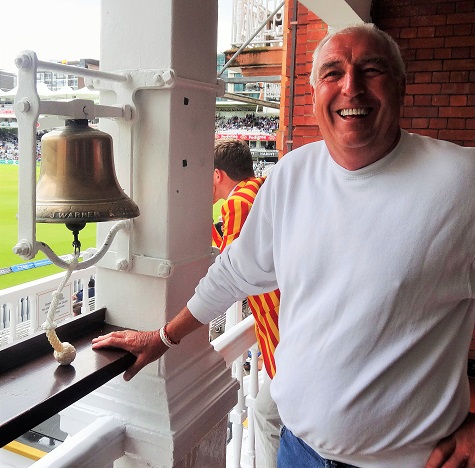
The MCC has a history of promoting from within their own ranks, so whilst the search for the next head groundsman will be a high-profile process - the groundwork, the team-spirit and the experience of senior colleagues working with Mick over the years will surely count for something.
Mick Hunt deserves the thanks of all cricket lovers and all those who revere the history and traditions of Lord's for being the ‘guvnor of grass’ for all these years.
We’ll miss the sight of him, in shorts, following his crew out to the middle during a crucial game, directing operations, having a quiet word with officials. Involved, committed, caring deeply for his Lord's.
His Test Match finale is beautifully set up following England’s victory over India on Saturday. A game played on a terrific, fair and sporting pitch prepared by Edgbaston’s Gary Barwell and you can be assured that the Lord's pitch will have been prepared to the same criteria.
Acknowledging that Mick will be a ‘tough act to follow’, John Stephenson, MCC Assistant Secretary says, “Mick Hunt’s place in the history of Lord's is assured”. Indeed, he has been involved in grounds preparation for a quarter of the time that Lords has hosted cricket.
All those in the turfgrass profession to whom he has been a role-model, all those in the world of cricket, will wish Mick Hunt a long and healthy retirement, and rather inadequately, say a heartfelt “Thank you!”
Chris Biddle is Consultant Editor of TurfPro and has been an MCC member for 55 years
Acknowledgments:
Thanks to the MCC for the image of Lord's (Sarah Williams) and James Glenday (ABC News)
I also reference the following books for quotes and facts:
A Portrait of Lord's: Adam Chadwick
Lord's, A Celebration in Pictures: Andrew Strauss OBE
The Complete Lord's Tests, 1884 - 2013: Jonathan Rice
The Forgiveness of Nature: Graham Harvey
 |
|
|
|